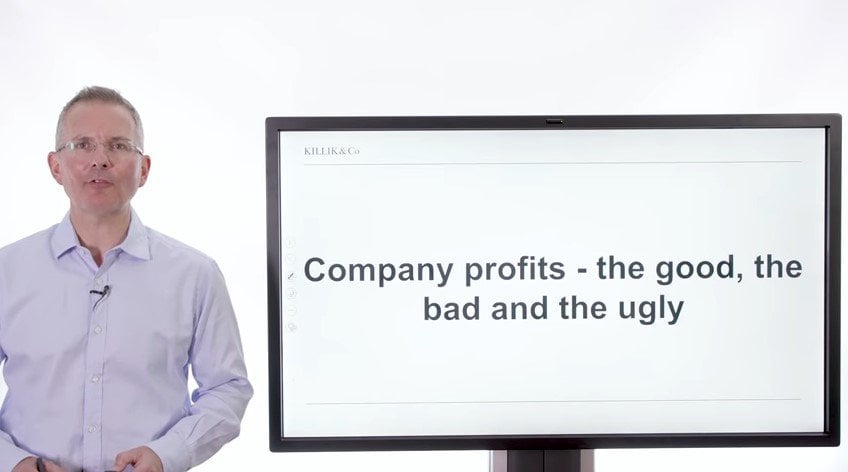There are many ways for firms to report profits, so how do equity investors choose the right number to follow? Tim Bennett takes a quick look.
Q2 hedge fund letters, conference, scoops etc

Killik Explains: Company Profits - The Good, The Bad And The Ugly
Transcript
Welcome to this Killik explains finance video this week. Company profits The Good The Bad and the downright ugly. OK what do I mean by this. Well a quick overview here. Rhumba funds have a motive. When they report profit numbers. So they want to make sure they hit their profits and earnings targets. Analysts are not disappointed. They want to present a smooth trend in profit earnings. Now that's because most firms share prices are a lot of them share prices are driven by changes. Profits earnings. But bear in mind that in some sectors the share price has be driven by sales growth stocks early stage companies cash flow income stocks in particular and assets investment property values. So management teams will also tends to have an eye on maintaining the right trend. Now as an investor you wouldn't be that cynical. So you want a profit metric that genuinely reflects the underlying profitable business. Hall to capture him one number you could to least challenge what numbers being presented and prioritized by management is not too subjective to change. And he's not too subjective and I would argue there are two of the hold off to profit numbers that can be reliable and there are a few that are more rogue and those are the ones to watch out for. Now my view is my personal opinion is I will disagree. But here it is. So the good guys. What are the numbers in there two. I think you can rely on. So these simple numbers. People's attitudes and Bubar actually simple is often a good thing.
Gross profit is one operating profit is the other and these are all required to be reported by firms signed off by the oldsters and so on. So a quick reminder of those people think and what are these. If I had a basic profit and loss account it would start with sales. Then you'd see a lot of cost deducted and along the way you'd hit some subheadings for profit. So there's more than one profit number. Gross profit is right at the top. It is simply the gap I've made up some numbers that make it more meaningful between sales and the direct cost of making those sales so cost that very directly with sales. So if your Marks and Spencer as the cost of the sandwich and the packaging and so on if we sell it on for a margin right. So before we go any further. Gross profit therefore his wallet. Its a fairly simple number but don't be fooled by the simplicity is useful. It's the profit generated when direct cost of sales are directed from sales. So just to use my previous example if sales of 500 million direct cost of making sales 400 one take away the other is 100 million. All right. You can do this is a margin so you can do the absolute number and you can do the profitability of the items sold. That's the margin. So to do that you just take the profit number. You decided to look at divide it into sales usually and express it as a percentage. Miss. Nice and simple 20 percent. The higher the better and the more consistent the better.
Now this one is favored by fund manager Terry Smith of funds Smith amongst others. He's not alone. It's difficult to manipulate. That's one of the reasons he likes it it's not impossible it's harder to light than other profit numbers. Look at the moment. It's also a useful measure of a company's ability to absorb shocks. If you got a low gross margin I'm afraid to Karelian demonstrated if things go wrong there's very little scope for maneuver cushioning that those are two reasons why for ministries and likes it. Now some people would say it's too simple and if a company isn't making profit you can't even calculate it. While maybe those are reasons to look twice at the investment. Next up another good guy operating profit. This is slightly further than the profit loss. So here you did up geal direct cost of sales. You also write right. You take off your admin expenses. These can be known as selling distribution and admin or overheads if you like. So my simple example is the gross profit figure 100 million deduct overheads. 80 million. And you hit operating profit. Notice I'm not taking out finance calls and I'm not taking out tax matters reasonably universally agreed. Why. Finance is not to do with the operation of the business it's to do with the way it's.






